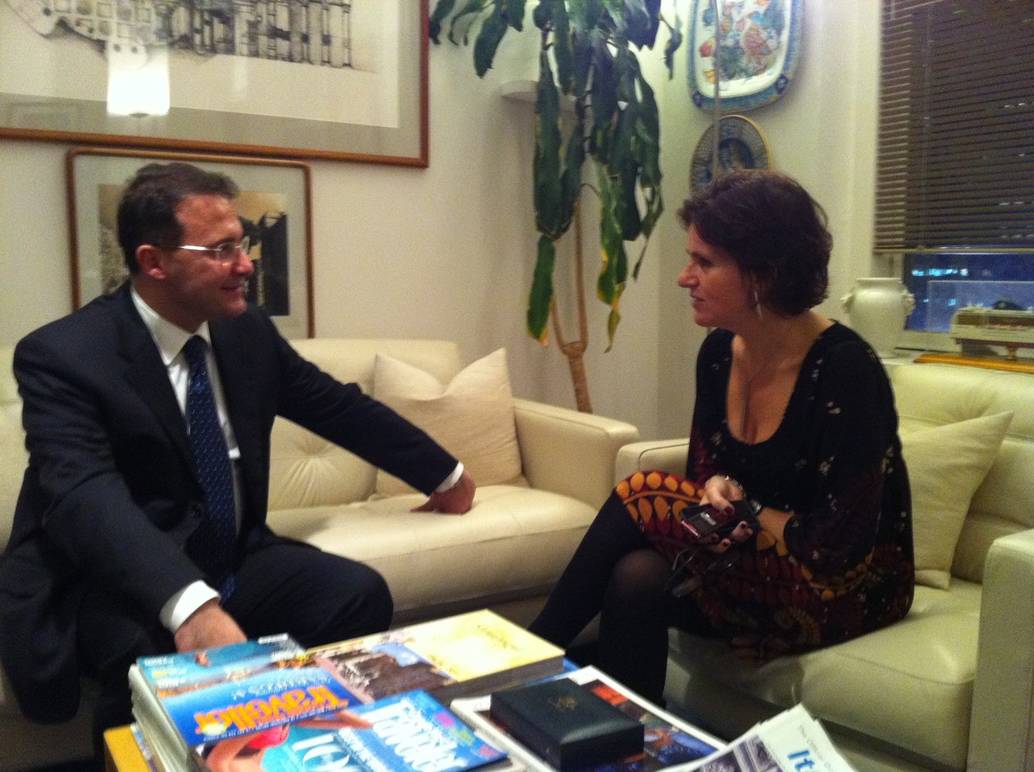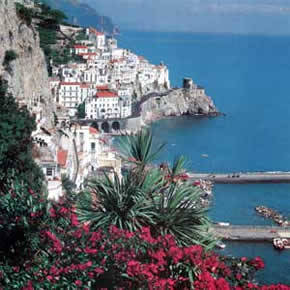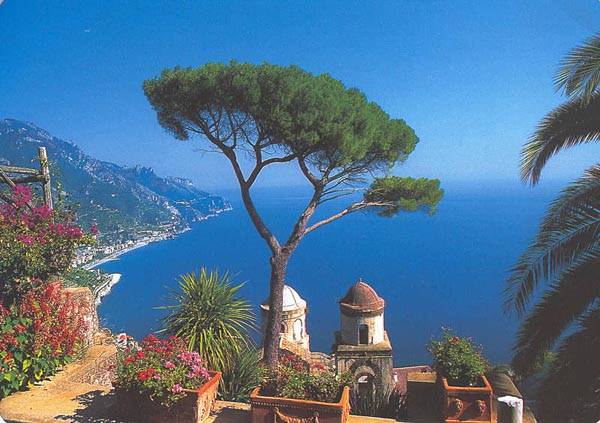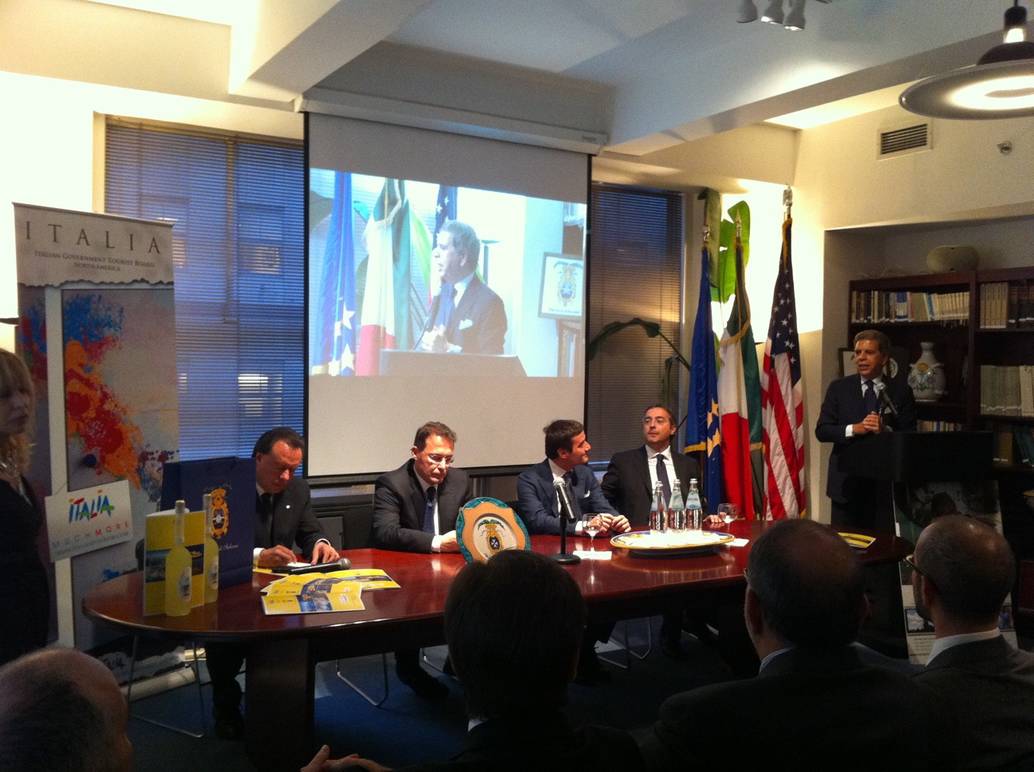The Poetry of the Province of Salerno
A deep blue sea caressing one of the most charming stretches of the Italian coast, an even deeper blue sky, breathtaking hillside landscapes, a cultural heritage dating back thousands of years and an intensely flavored cuisine based on the several outstanding local products that this generous land has bestowed upon its inhabitants since before the Roman empire. The Province of Salerno, one of the Italian hidden jewels waiting to be discovered by international tourism, is where you can find all of this, as the American press found out on October 26 at the Italian Government Tourist Board.
It was most definitely not an ordinary team of panelists the one that led the event, which was moderated by Riccardo Strano: Hon. Edmondo Cirielli, President of the Province of Salerno; Hon. Amato Berardi, member of the Italian House of Representatives; Attorney Adriano Bellacosa, Minister for the Cultural Affairs of the Province of Salerno - Ciro Castaldo, Director of the Dept. of Tourism of the Province; Francesco Maria Talò, Consul General in New York; Berardo Paradiso, President of the Italian American Committee of Education and Antonio Benetti, Director of the Education Office at the Italian Consulate General.
The area of Salerno is one of the biggest in Italy: with its 5000 square kilometers and 20 km of coast, it encompasses 40% of the Region of Campania. This beautiful land has a few sites that are well-known also outside of Italy: Positano and Amalfi are in fact part of this Province.
With its truly amazing mix of nature, culture, history and eno-gastronomical tradition, the Province has a great touristic potential.
Due to its geographical size, the Province, in the words of Consul Talò, is like “Italy in miniature”, since it offers both a breathtaking coast and a still untamed mountain wilderness: the National Park of Cilento, one of the biggest National Parks of Italy and one of the 2 UNESCO Humanity Heritage Sites this land can pride itself of, the other one being the Amalfi Coast. This province has a very low population density, with most of its inhabitants living in small rural communities. It’s easy to imagine how a trek through the Cilento Park alternates idyllic, untouched patches of pure nature, to small characteristic villages where the discerning tourist can find local specialties.
If you are looking for cultural and artistic sites to visit, this Province will not let you down. With settlements dating back to the Ancient Greeks, the cultural sites found here span from the ruins of Paestum, a beautifully preserved Greek colony founded in 7 BC, and the acropolis of Velia, seat of the Eleatic school of the philosophers Parmenides and Zeno, to the paleo-Christian baptistery of Nocera Superiore and the Certosa of Padula, a stunning 1000-year-old (actually 999 years old: they will celebrate their millennium in 2011) carthusian monastery. If this is still not enough for you, a trip to Cava de’ Tirreni, a village hosting one of the best examples of Baroque architecture found in Italy, will probably do the trick.
The love this land reserves to the world of art is still alive today: the Giffoni Film Festival, held in the small town of Giffoni, is the most important children’s film festival in Europe. Recently its popularity increased exponentially, so much that it was chosen for the world’s first preview of “Harry Potter and the Half Blood Prince”.
Over the years the province of Salerno inspired many artists. Hemingway wrote part of his Novel “The Old Man and the Sea” on these shores, and Wagner composed “Parsifal” in the city of Ravello, that is now the location of a music festival popularly known as “Wagner Festival”.
A visit to this territory will not only tempt your from a cultural point of view, but also from the food&wine one. In fact, it is well known that the best Buffalo mozzarella is produced here, and each village has its own specialty often celebrated by town festivals. A few examples are the pizza in Tramonti, the sardines in Trani and the tuna in Cetara. To have an idea of how serious the locals are about food, note that the small village of Cetara – with its little more than 2,000 inhabitants – hosts one of the best tuna fishing fleets in Europe.
Another world-renowned product original from here is the Limoncello, typical spirit made with the skins of lemons ripened under the ever-shining summer sun.
President Cirielli was also quite proud of another characteristic of his Province: even though it is very close to Naples, it has managed to remain untouched by the problems that affect everyday life the bigger city. Low criminality and high efficiency make of this province an example for all of Southern Italy. The “garbage crisis” of which the world has spoken so much, never moored at Salerno’s docks. High-speed trains provide top-notch connections to Rome and, as of December 1, the city airport will have flights to both Milan and the capital.
The conference was followed by a buffet of typical products from Salerno. In this informal atmosphere we interviewed Riccardo Strano, Director of the Italian Government Tourist Board and host of the event.
As he told us, "last June, we collaborated with the Province in the elaboration of a certification program: we sent forty tour operators to Salerno. This is a follow-up to the work that has already been done. The theme back then was ‘archeology’. That means: Paestum, the Cilento park region, and obviously the Amalfi Coast. Salerno tonight is advertising its most striking features, among them the eno-gastronomical tradition: you might have noticed the ‘Limoncello’ bottles.
It is important to point out that this beautiful province has two UNESCO sites: one is the Paestum and Vallo di Diano site, and the other the Amalfi Coast. This is nearly a record for one Province.
In the mind of the average American tourist, the Amalfi Coast encompasses only Amalfi and (maybe) Positano. It is important to inform people that these places are part of the Salerno Province, and this province has the God-given luck of being extraordinarily beautiful under both a naturalistic and a cultural point of view. Greek, Norman and Arabic cultures met in this region and created a highly developed aesthetic and cultural sensibility, so much so that for a brief amount of time Salerno was the kingdom’s Capital City.
If you merge this sensibility with the beauty of the landscape, you have a winning recipe for all kinds of tourism. The highest concentration of hotels in Italy - and among those the best hotels of the country – is between Positano and Amalfi, Maiori and Minori, and Ravello.”
-----------------------------
"Younger tourists & the Province of Salerno"
Interview with President Cirielli
How does your Province appeal the younger tourists?
“First of all you have to remember that this is the Province with the youngest demographics in Italy. Its entertainment infrastructures have a great appeal on young people. The cities of Cava and Salerno are crowded with groups of kids coming from Naples and the rest of the Campania Region in winter time, while Amalfi and the Cilento Coast attract a large number of young people during the summer. Furthermore, criminality in Salerno is close to zero. We have had no serious problem for years: young people can be safe and have fun at the same time and their parents can finally have some rest.”
The Province is quite large. This allows for some kind of “exploratory” tourism. This also should intrigue younger tourists...
Being nearly as big as a Region, this Province offers a multitude of options to the avarage tourist, inclusin the sea shore, the mountains, eno-gastronomical traditions, religious sites…
It is not by chance that the Giffoni Film Festival is becoming so popular. Two years ago Warner Bros chose the GFF for the world preview of Harry Potter and the Half Blood Prince. Being chosen by an American company for such a big event was quite an endorsement and signal of how important youth culture is for our Province.
During the presentation you described your land very well. What I would like to dwell on a little longer is the possibility of finding places of unscathed natural beauty, still uncontaminated by modernity. Such places are getting more and more difficult to find even in a country like Italy.
Those places can be found mostly in the Cilento territory. It’s the chosen holiday destination for many young tourists. An extremely safe and quiet area with a beautiful wild coast. It is a much less organized zone than the Amalfi coast. This pinch of adventure actually increases the savage appeal of the region for younger crowds. Furthermore, it is a very inexpensive place, with hostels and camping spots where one can spend time in communion with nature without paying exorbitant prices. There is an extremely healthy gastronomical tradition and the Park of Cilento is just next door.
I feel that this region has a lot in common with Tuscany.
Tuscany is a little ahead of us when it comes to hospitality and organization. However we have some common traits. This is a huge, scarcely populated region where tourists can find beautiful countryside landscapes, natural parks and reserves. There is a strong gastronomical tradition, which is quite different from the Tuscan one: ours is a little more rich and elaborated due to all the ingredients harvested from the sea. The same is true for artistic and cultural tourism: we are not as developed as Florence, yet, but I wouldn’t say we have a smaller potential. For example, the city of Paestum and its 6 kilometers of walled circumference is the only city from the Greek-Roman culture to have reached us, and it is truly something unique in the world.
I remember that a long time ago I interviewed a priest from this region. He used to help local people to reach the United States. Is there some kind of ongoing relationship between these emigrants (and their families), and their relatives who stayed in Salerno?
Unfortunately there isn't such a strong tie. One of the goals of my trip to the States is also to recreate this lost bond.
Is there any initiative regarding this matter?
We want to create a foundation of the Salerno emigrants in the world. Keep in mind that this is a very big Province; we had lots of emigrants, especially before World War II.
What are you doing to make of your province a major tourism destination?
Until now nearly nothing has been done. The local government preferred to invest into local festivals rather than the promotion of the area. Now we are buying advertising space on specialized publications and placing billboards in train stations and airports. We are also traveling to promote the identity of our Province. Many places in our region, interesting and charming places, are linked in the minds of tourists to Naples. First of all, we are not Naples and we are proud of our identity; secondarily this link often taints these places with the flaws Naples is usually associated with, and those flaws are not part of our culture and system, as I explained in the presentation.
We still have to work on our presence on the Internet.
What will your goals be two years from now?
We have to increase the length of the tourist seasons, even on the better-known Amalfi coast. We want to improve our offer through a better education of young people and subsequently increase the number of them working in the tourism sector. At the moment that number is way too low: we have a strong emigration and unemployment and not being able to guarantee a good future in our land to our youngest generation is something I truly want to change.








































i-Italy
Facebook
Google+
This work may not be reproduced, in whole or in part, without prior written permission.
Questo lavoro non può essere riprodotto, in tutto o in parte, senza permesso scritto.